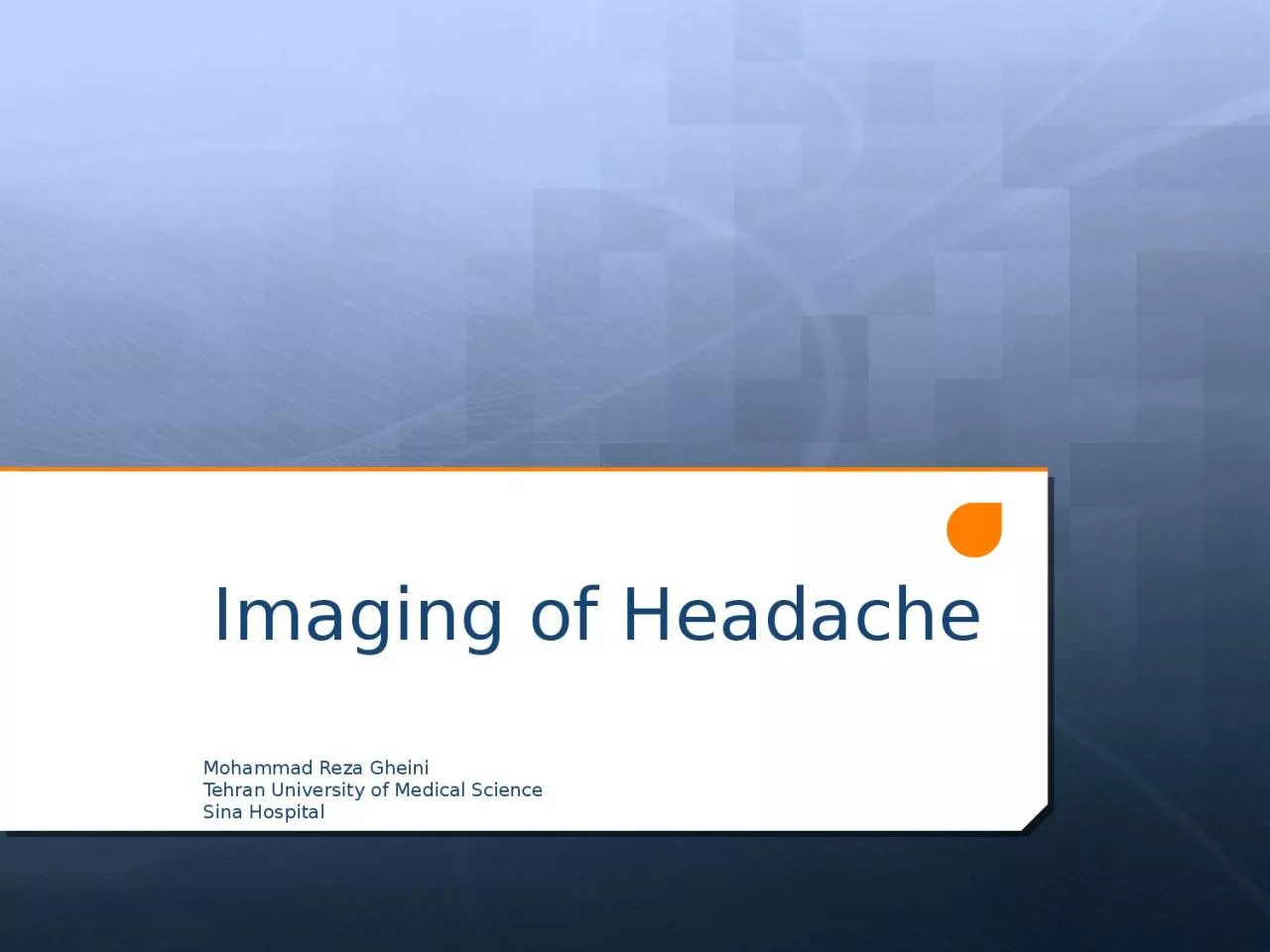

Gheini Tehran University of Medical Science Sina Hospital Headache Headache is the most often reported neurological symptom in outpatient neurological officeheadache has more than 300 types ID: 933913
Download Presentation The PPT/PDF document "Imaging of Headache Mohammad Reza" is the property of its rightful owner. Permission is granted to download and print the materials on this web site for personal, non-commercial use only, and to display it on your personal computer provided you do not modify the materials and that you retain all copyright notices contained in the materials. By downloading content from our website, you accept the terms of this agreement.
Slide1
Imaging of Headache
Mohammad Reza
Gheini
Tehran University of Medical Science
Sina
Hospital
Slide2Headache
Headache is the most often reported neurological symptom in outpatient neurological office.(headache has more than 300 types.)
The big question is whether or not it is necessary to perform neuroimaging in order to confirm a distinct headache diagnosis.
In a resource-restricted medical environment this is sometimes difficult to justify to perform neuroimaging for every patient with headache.60% of patients in a British regional headache clinic were afraid that they were suffering from a serious illness because of the headache. Two-thirds of them expressed the wish for neuroimaging [Fitzpatrick an.
1- Fitzpatrick, R. and Hopkins, A. (1981) Referrals to neurologists for headaches not due to structural disease. J
Neurol
Neurosurg
Psychiatry 44: 1061–1067.
Slide3Imaging of headache
A prospective study of chronic headaches seen in a neurology clinic had a 1.2% rate of significant abnormalities on imaging.
(1)
It is important to obtain imaging appropriately to differentiate between secondary and primary headache disorders .Clinical judgment and clinician experience play a key role in deciding when to use imaging.
1-Sempere AP, Porta-
Etessam
J, Medrano V, et al. Neuroimaging in the evaluation of patients with non-acute headache. Cephalalgia 2005;25
Slide4Red flags in headache.(SNOOP5)
S: Headache with signs of
S
ystemic illness (fever, stiff neck, rash) or risk factors such as HIV infection or cancerN: Abnormal Neurological examination (others than typical aura)O: New headache in Older patientsO: Sudden
O
nset of headache or Worst headache ever
P:
P
apilloedema
P:
P
rogressively worsening headache (increasing in frequency and severity)
P:
P
ostural headache
P:
P
recipitated by with Valsalva maneuver
P: Pregnancy
Slide5Usefulness of Imaging
A large review of 3026 scans of patients with headache:
0.8% brain
tumours; 0.2% arteriovenous malformations; 0.3% hydrocephalus; 0.1% aneurysm; 0.2% subdural haematoma
;
1.2% strokes, including chronic
ischaemic
processes
Evans, R. (1996) Diagnostic testing for the evaluation of headaches.
Neurol
Clin
14: 1–26.
Slide6Red flags in headache
Abnormality on neurologic examination is the most consistent and robust predictor of intracranial pathologic conditions on subsequent imaging.
Neurologic imaging is usually not warranted for a migraine headache with normal neurologic examination findings, although exceptions can exist.
Slide7Which neuroimaging should be performed?
MRI
offers a greater resolution and discrimination and might therefore be the preferred method of choice in
nonacute headache.In the setting of the emergency department, a noncontrast CT scan is often performed first due to speed, convenience, and a frequent need to rule out a hemorrhage.
Slide8Severe thunder-clap headache
Estimates of finding SAH is in the range of 11% to 25%
Non–contrast head CT
If negative, it is followed by a lumbar puncture.A non–contrast head CT is 92% to 95% sensitive for detection of acute SAH on the day of the aneurysm rupture.Estimates of rates of SAH confirmed by lumbar puncture after negative CT results are in the range of 2.5% to 3.5%.
Slide9SAH
Slide10New onset headache ,unilateral, that is radiating into the neck with ipsilateral Horner syndrome.
CTA
or MRA
If MRA is performed, the T1 axial fat-saturated sequence is routinely added for evaluation of intra-mural hematoma.MRI with DWI should also be considered to eval-uate for any associated strokes.
Slide11Slide12Pregnancy and Postpartum Period
These patients have a higher yield of intracranial pathologic conditions than the general population.
Neuroimaging, including non–contrast head CT and MRI, revealed an underlying headache cause in 27% of pregnant patients presenting to an emergency department
Diagnoses included CVT, posterior reversible encephalopathy syndrome (PRES). The odds of having an intracranial abnormality on neuroimaging were 2.7 times higher in patients with an abnormal neurologic examination.
Slide13Imaging during Pregnancy
An MRI brain scan without gadolinium is safe in all trimesters in pregnancy and, in fact, is the preferred imaging modality to search for structural causes of secondary headaches in pregnancy
The administration of gadolinium-based MRI contrast should be deferred during pregnancy when possible but may be administered if clinically necessary because no risk has been specifically found.
If a lactating patient receives intravenous iodinated or gadolinium-based contrast, discarding breast milk may be recommended for 24 hours after contrast administration.
Slide14Cerebral Venous Thrombosis
Diagnosis of Cerebral Venous Thrombosis With Echo-Planar T2*-Weighted Magnetic Resonance Imaging
JAMA Neurology
59(6):1021-6 · July 2002
Slide15White matter hyperintensities in migraine
Slide16White matter hyperintensities in migraine
White matter
hyperintensities
are present in 43.1% of migraine patients.
Risk factor for development of white matter
hyperintensities
.
Age
Presence of aura,
Disability during attack,
Resistance to treatment.
Severity of headache
Duration of migraine
Slide17Take home message
Although most headaches are a primary headache disorder with a
benign
course, imaging is an important part of the diagnostic evaluation to exclude the presence of a secondary cause of headache.In patients with headache but without focal neurologic examination abnormalities, the yield of neuroimaging for significant intracranial findings is generally low.For headaches that are suspicious for intracranial hemorrhage, particularly those presenting acutely, the initial
neuroimaging
study is usually a CT scan.
Headaches presenting with a chronic course or in the outpatient setting can usually be initially studied with MRI.
Slide18